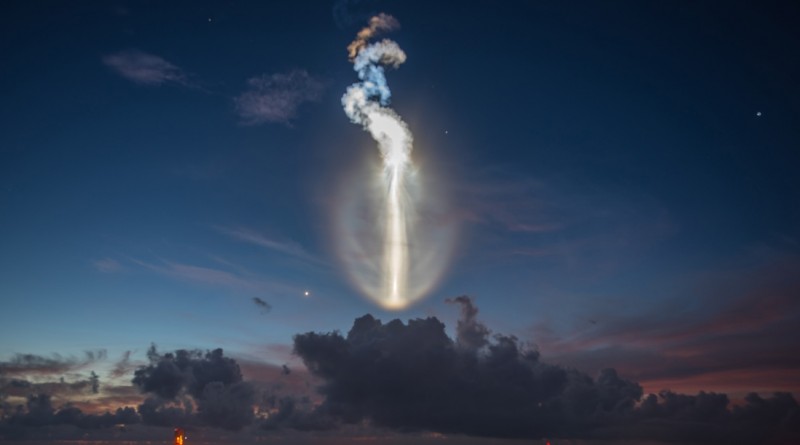Atlas V puts on a Show, successfully lofts fourth MUOS Satellite
Originally published September 2, 2015
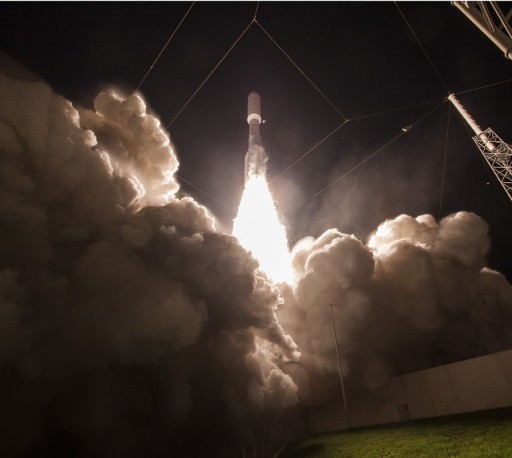
A United Launch Alliance Atlas V 551 rocket thundered into the early morning skies over Florida’s Space Coast on Wednesday, departing Cape Canaveral Air Force Station for a long mission to deliver the fourth MUOS satellite to orbit for the Multi-User Objective System. Liftoff from Space Launch Complex 41 took place at 10:18 UTC, marking the start of a three-hour ascent mission, aiming for a highly elliptical Geostationary Transfer Orbit.
Sporting five Solid Rocket Boosters, the 551 version of the Atlas V is the most powerful variant of the launcher currently in operation. Firing up its RD-180 Core Stage engine and the five boosters, Atlas V quickly jumped off its pad and shot skyward, completing a vertical ascent of just a few seconds before swinging to the south-east to depart the space coast. The five boosters operated for a little over 90 seconds and cleanly separated from the 62-meter tall rocket that continued onwards powered by the RD-180 alone – putting on a spectacular show in the skies over the space coast. The first stage finished its job four and a half minutes after launch, handing off to the trusted Centaur upper stage that was tasked with three engine burns.
The first burn was nearly eight minutes in duration and successfully inserted the vehicle into a Low Earth Parking Orbit. The next burn was almost 6 minutes in duration and boosted the high point of the orbit to set up for a long coast phase of two and a half hours so that the third burn could serve as a combined perigee & apogee raising maneuver, achieving a Geostationary Transfer Orbit with increased perigee. Spacecraft separation was successfully carried out 2 hours and 53 minutes after liftoff with confirmation of mission success provided shortly thereafter.
MUOS 4 follows in the footsteps of three previously launched MUOS satellites, the first of which entered orbit in 2012 followed in 2013 by the second and earlier this year by the third. Four MUOS satellites are needed to achieve a global coverage, delivering Ultra-High Frequency communications to military and government users including mobile terminals. MUOS 4 will complete the deployment of the active MUOS constellation reaching its full capacity. A fifth MUOS satellite is slated for launch in 2016 to act as an in-orbit spare, being able to drift to any given location to take over for a failed satellite, ensuring a continuation of full-capacity services.
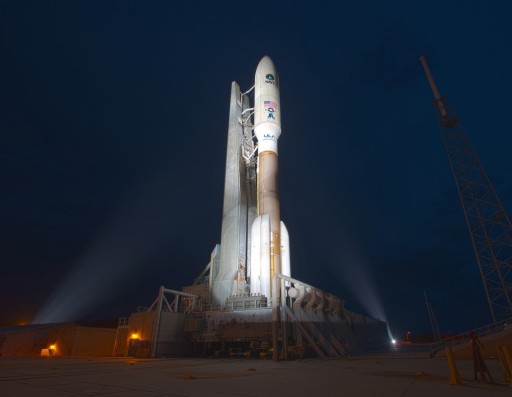
Services provided by MUOS include cellphone-like data, video and voice connections between two or more users around the globe as part of point-to-point or netted communications setups. Connections can be established and released within seconds to permit flexible communications catered to current demands. MUOS satellites are among the heaviest satellites flown into orbit by the Atlas V, weighing in at 6,740 Kilograms – requiring the Atlas V powerhouse to fly in its 551 configuration.
Launch countdown operations at Cape Canaveral Air Force Station picked up at 11:14 p.m. local time on Tuesday as the Atlas V launch team reported to console at the Atlas Spaceflight Operations Center. The first step of the long countdown was the setup of ground systems and voice checks between the various launch support stations and the various ground stations involved in the mission. Data flow tests with the Tracking and Data Relay Satellite System were performed as well. Out at the launch pad, teams were busy with the final set of close out operations to put the launch vehicle and the ground support systems in a good configuration for liftoff.
Completed as the first major countdown step was the activation of the Atlas V rocket to mark the start of an extensive set of testing operations including Flight Control System, electrical and propulsion system testing, Flight Control System verifications and communication checks completed in C- and S-Band. Weather balloons were released periodically to record the environment in the upper atmosphere and Atlas V nitrogen purge flow was initiated in preparation for tanking. With all launch pad systems in the proper launch configuration, all teams evacuated the Blast Danger Area, setting up road blocks as they departed to a fallback area.
Reaching T-2 hours, the countdown entered the first of two built-in holds to allow the Launch Team to complete any outstanding steps in their tanking preparations and conduct the necessary polls and briefings before the hazardous propellant loading operation. Looking at a favorable weather forecast, a clean launch vehicle and a clear blast danger area, the Launch Team provided a unanimous GO to head into tanking operations.
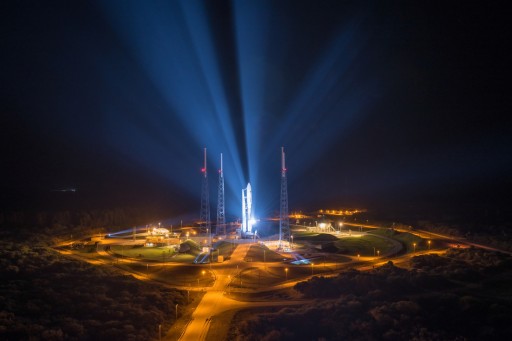
As soon as countdown clocks picked up at T-2 hours, the complex propellant loading procedure commenced with the initiation of the pressurization and chilldown of the Ground Support Equipment and Transfer Lines of the Liquid Oxygen System. When transfer lines and Mobile Launch Platform systems were chilled down, teams proceeded with the chilldown of tanks on the Centaur Upper Stage and the Common Core Booster.
Passing L-2 hours, the -183°C LOX began flowing into the Centaur Upper Stage followed about ten minutes later by oxidizer loading on the Core. Both tanks started out in slow fill mode to load the initial portion of the tank before fast fill was initiated to rapidly fill up the tank to the 95% level at which topping was initiated to top-up the tanks at flight level and keep replacing propellants as the supercold LOX naturally boiled off and was vented overboard. In total, the Common Core Booster was loaded with 185,500 liters of LOX while Centaur received 15,700 liters.
Rocket Propellant 1 loading on the Common Core Booster was completed on Monday as the large core stage received 94,600 liters of highly refined Kerosene suitable for combustion in high-performance rocket engines. With the beginning of the tanking operation, the CCB fuel tank was pressurized to an intermediate pressure to stabilize the rocket.
The last tank to be filled during the countdown was the Liquid Hydrogen Tank of the Centaur Upper Stage. During the setup for LH2 chilldown ops, the launch team noticed a misconfiguration in a Nitrogen purge system, requiring the countdown to be stopped at T-1 hour and 22 minutes for an unplanned hold to address the issue. While the nitrogen issue was being fixed, LOX on the core stage and Centaur continued loading without interruption. It took teams 26 minutes to solve the issue, leaving 18 minutes in the day’s launch window when the count resumed at T-1 hour and 22 minutes.
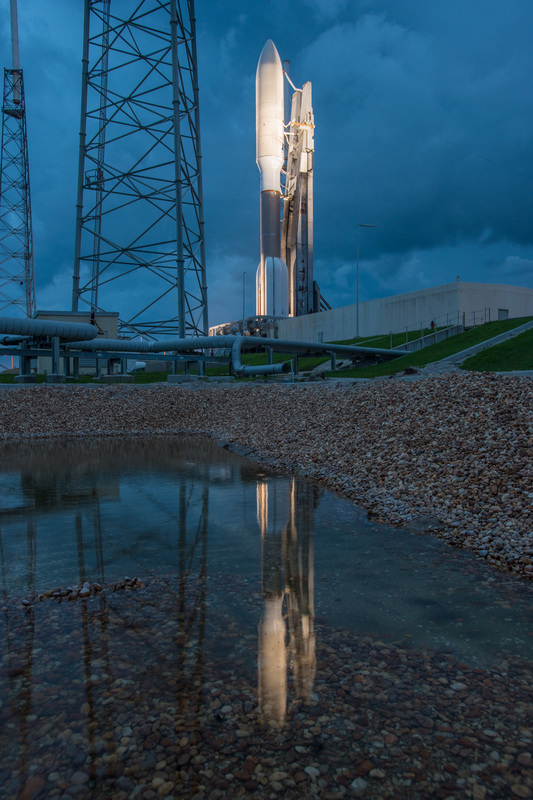
Pressurization and chilldown of the LH2 ground handling system commenced without issue followed by the chilldown of transfer lines and the fuel tank. A short time later, the -253°C fuel began flowing into the tank, taking about 20 minutes to head from slow fill into fast fill and reach topping with a total of 48,100 liters of LH2 aboard the upper stage.
When flying in its massive 551 configuration, Atlas V uses the Common Core Booster with five AJ60 Solid Rocket Motors, topped by the trusted Centaur stage and the large 5.4-meter diameter payload fairing of Atlas V offering enough space to the MUOS satellite. The launcher stands 62.2 meters tall with a pan on its base of 6.9 meters and a total launch mass of 587,000 Kilograms.
The Common Core Booster stands 32.46 meters tall with a diameter of 3.81 meters and an inert mass of 21,054 Kilograms. At launch, it holds a total propellant load of 284,089 Kilograms. It is powered by a single 4,152-Kilonewton two-chamber RD-180 engine. Each of the five Solid Rocket Motors is 20 meters long and 1.58 meters in diameter loaded with 40,957 Kilograms of propellant to generate 1,688 Kilonewtons of thrust.
Centaur stands 12.68 meters tall and 3.05 meters in diameter with an empty mass of 2,243 Kilograms. In total, Centaur carries 20,830kg of propellants at liftoff inside pressure stabilized stainless steel tanks. Recently switching over to the RL-10C engine, Centaur has gotten a slight performance boost and took the first step in the simplification of rocket design as Delta IV and Atlas V switch from two different RL-10 designs to the common RL-10C over the coming years. RL-10C is manufactured from existing RL-10B-2 engines by substituting their extendable nozzles with a smaller carbon-carbon extension, adding a dual spark igniter and propellant utilization systems. Overall, RL-10C delivers 106 Kilonewtons of thrust at a specific impulse of 448.5 seconds.
Entering the last hour of the countdown, all tanks reached stable replenish, the helium bottles on CCB and Centaur achieved flight mass and the Atlas V hydraulics system was pressurized for a test of the Thrust Vector Control System of the RD-180 along with a steering check run on the RL-10 engine. Atlas V went through a second round of Flight Termination System testing and its computers received an updated version of the flight software based on the latest measurements of conditions in the upper atmosphere. The RD-180 engine completed the filling sequence of its high-pressure RP-1 tank used in the ignition sequence.
The countdown entered its second pre-planned pause at T-4 minutes to allow teams to catch up on any open tasks – none of which were left – and provide time for the final Go/No Go Poll.
Making up for lost time, the launch team shortened the hold from 15 to 8 minutes to preserve as much window time as possible after the earlier hold-up in the countdown. During the hold, MUOS 4 finished its transition to internal power and switched to flight mode, allowing the spacecraft team to provide a GO to the launch team.
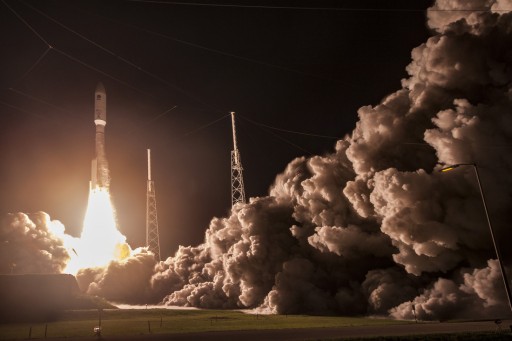
Terminal countdown operations commenced at 10:14 UTC as computers assumed control of the final critical countdown steps to transition the Atlas V rocket to its autonomous liftoff configuration while checking all systems statuses every step of the way.
With three minutes left in the countdown, the Common Core Booster secured its LOX tank by closing valves and beginning the pressurization of both tanks to the proper flight pressure. The Flight Termination System was switched to internal power two minutes and 45 seconds ahead of launch followed 20 seconds later by the arming of the system to be used as a last resort in the event of a launch vehicle failure.
Passing the T-2-minute mark, Atlas V transitioned to internal power and started its onboard countdown sequencer that assumed control of the last set of preparatory steps. The LOX and LH2 tanks on the Centaur upper stage headed into pressurization at T-1:50 and T-1:40, respectively. A final verification of the hydraulic system showed nominal pressures and bus voltages were nominal as well. The Flight Termination System started its own countdown sequence and the Eastern Range provided final clearance one minute ahead of launch.
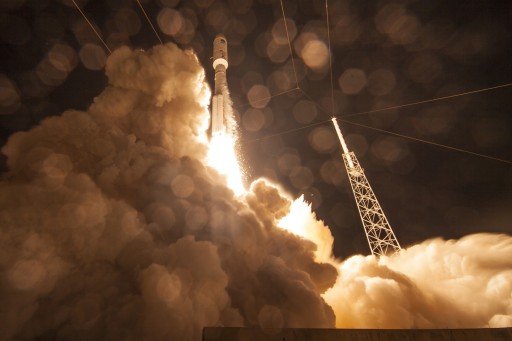
At T-2.7 seconds, the powerful RD-180 engine came to life – going through a complex ignition sequence that started with the injection of pyrophoric TEA into the engine gas generator and chamber to trigger the ignition when the substance came into contact with Liquid Oxygen also injected into the engine. As the combustion process started in the gas generator, the engine turbopump began spinning and the injection of fuel into the gas generator and the chambers kept up the combustion process, allowing the engine to build up thrust. Computers monitored the ignition & ensured RD-180 reached its nominal launch thrust of 390,000 Kilogram force.
With RD-180 up and running, Atlas V sent the ignition command to its five AJ60 Solid Rocket Boosters, committing the vehicle to flight. Upon ignition of the solids at 10:18:00 UTC, Atlas V thundered off with a total thrust of 1,250 metric-ton-force creating an initial thrust to weight ratio of 2.15 – making for a quick initial climb.
Atlas V rose vertically for under ten seconds before initiating is roll and pitch maneuver to get aligned with its precise ascent path, headed to the south-east along a 94.58-degree launch azimuth. Response to the roll was nominal as called out by the Launch Team, showing good pressures in the boosters and RD-180 engine as well as stable bus voltages and Flight Control performance.
Propellant Utilization was switched to closed loop control around thirty seconds into the flight to allow the system to automatically adjust the LOX to Kerosene mixture provided to the engine to ensure an optimized consumption of propellants.
Once the pitch maneuver was complete, Atlas V switched to its Zero Angle of Attack flight profile, still using the pre-programmed attitude profile that was computed for the measured conditions in the upper atmosphere. The Atlas V rocket pushed through Mach 1 just 37 seconds after liftoff, burning through 3,300 Kilograms of propellants each second of the flight. Maximum Dynamic Pressure was encountered by the vehicle when passing the T+51 second mark as Atlas V was making its way through the dense layers of the atmosphere at supersonic speeds.
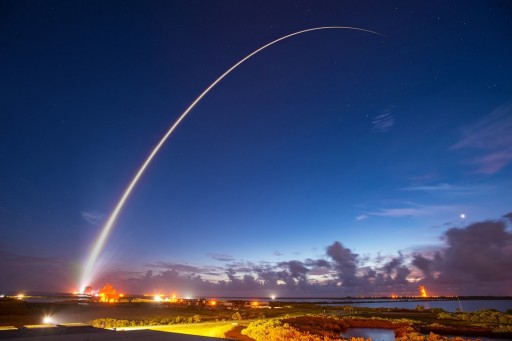
Each of the five Solid Rocket Boosters delivered a thrust of 172,000 Kilogram-force to help send Atlas V on its way into orbit, delivering the majority of thrust during the initial flight phase. Thrust on the boosters began declining at T+94 seconds after each burned over 40 metric tons of propellants.
The pressure drop inside the boosters signaled their burnout to onboard computers, but to ensure a safe off-shore impact, the Atlas V held the boosters for another 12 seconds. Booster separation took place in two groups, beginning with two boosters followed 1.5 seconds later by the remaining three – using pyrotechnics to jettison the SRBs. RD-180 was used to correct transient body rates induced by the separation of the boosters.
With a clean jettison of the five boosters, Atlas V relied purely on its Russian-built RD-180 engine, burning 1,150 Kilograms of LOX and Kerosene per second to generate a massive vacuum thrust of 422,400 Kilogram-force. The two-chamber engine is a close relative to the four-chamber RD-170 version. It is 3.15 meters in diameter and 3.56 meters long weighing 5,480 Kilograms. RD-180 maintains a high-pressure staged combustion cycle employing an Oxygen-rich preburner requiring an exceptionally high chamber pressure of 267 bar.
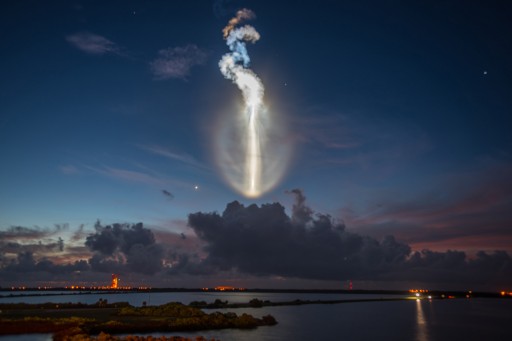
Atlas V continued its ascent as planned, flying right down its launch corridor with good RD-180 performance. While the Common Core Booster was still firing, the Centaur Upper Stage completed a series of activities to get ready for its first burn. The pyrotechnic valve of the Reaction Control System pressurization bottles was fired to fully pressurize the Hydrazine tanks to feed the 12 attitude control thrusters mounted on Centaur. Also, the boost-phase chilldown of the RL-10 engine of Centaur was started to condition it for ignition.
Heading uphill, Atlas V was illuminated by the sun while it was still dark along Florida’s Space Coast. Also bathed in sunlight was the expanding cloud of exhaust gases released by the RD-180 engine, creating the well-known jellyfish phenomenon that was visible for several minutes before the white glowing cloud of gas dissipated in the tenuous upper atmosphere.
The RD-180 engine throttled own for a brief moment after passing the T+3 minute mark to permit a safe separation of the payload fairing. Pyros were fired at T+3 minutes and 22 seconds to split open the two halves of the fairing that then rotated outward on hinges and cleanly separated from the launch vehicle, eliminating some no-longer needed weight as the MUOS 4 satellite could not be harmed by aerodynamic forces at these altitudes. The Forward Load Reactor was jettisoned shortly after the fairing to continue the process of shedding weight that was no longer necessary. To fit the large MUOS satellite under its protective fairing, Atlas V flew with the medium 5.4-meter diameter fairing measuring 23.4 meters in length and providing sufficient space to the satellite.
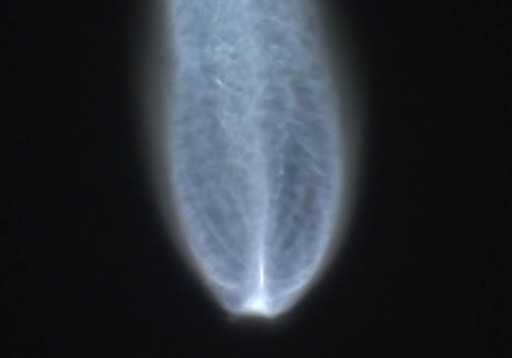
Passing T+4 minutes, Atlas V entered its throttle segment, gradually reducing thrust on the RD-180 to limit G forces encountered by the vehicle to 4.6Gs approaching the end of the first stage burn.
Shutdown of the RD-180 was confirmed just before hitting T+4 minutes and 30 seconds with staging coming moments after BECO as separation pyros were fired and eight retrorockets ignited on the core stage, pulling it away from the Centaur, headed for re-entry and impact in the Atlantic.
Centaur immediately began the purge of its reaction control system and pre-started the RL-10C engine on LOX and LH2. Ignition of the engine was confirmed four minutes and 40 seconds into the flight on a planned 7-minute and 45-second main engine burn, tasked with delivering the stack into a slightly elliptical Low Earth Parking Orbit. Shutting down its engine around 12 and a half minutes into the mission, Centaur achieved an orbit of 166.6 by 660.6 Kilometers inclined 28.3 degrees.
Taking the standard route from Cape Canaveral to a Geostationary Orbit with increased perigee, Centaur settled in for a short coast phase of eight minutes so that its second main engine burn could take place centered over the equator which leads to an apogee/perigee position above the equator, the preferred position for Geostationary Transfer Orbits.
Because Atlas V 551 can deliver up to 8,700kg into a standard GTO of 185 by 35,786 Kilometers, lofting the 6,740kg MUOS left the vehicle with some additional performance that was to be used to raise the perigee and slightly decrease the orbital inclination in order to reduce the amount of propellant that the spacecraft has to use in order to reach a Geostationary Orbit.
At T+20.5 minutes, RL-10 re-ignited on its second burn with a planned duration of 5 minutes and 47 seconds, set up to significantly raise the apogee altitude of the orbit to nearly match Geostationary Altitude. Throughout the burn, RL-10 showed rock-solid performance and placed the stack into a 191 by 32,984-Kilometer orbit inclined 25.95 degrees to either side of the equator.
With the successful insertion into its preliminary transfer orbit, the vehicle entered a coast phase of 2 hours and 22 minutes. This long coast was needed in order for Centaur to climb uphill in its elliptical orbit so that the third burn could occur at a point between perigee and apogee leading to an increase of both altitudes, aiming to raise the apogee to Geostationary Altitude while getting the maximum out of Centaur for the perigee-raising and inclination reduction.
The coast phase took Centaur over south-central Africa, heading out over Madagascar for a pass over the Indian Ocean.
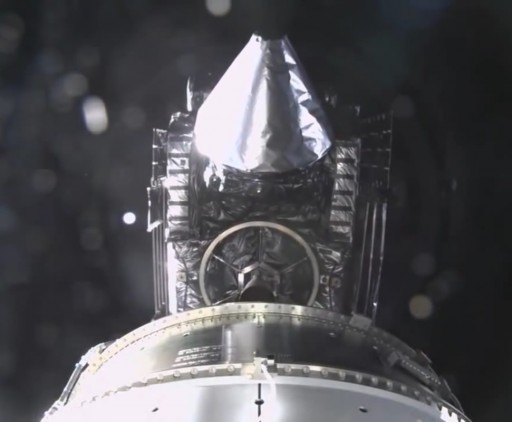
Centaur ignited its engine for the third time at T+2 hours and 49 minutes and fired the RL-10C for 58.3 seconds. Performing the burn out of plane, Centaur aimed to reduce its orbital inclination while raising perigee and apogee. MUOS 4 was targeting an insertion orbit of 3,819 by 35,786 Kilometers at an inclination of 19.11 degrees. Following burn completion, Centaur re-oriented for the separation of the satellite.
MUOS 4 was sent on its way 2 hours and 53 minutes after launch to mark the start of its 15-year mission that begins with a series of eight orbit-raising maneuvers over the next week and a half to place the spacecraft into a Geostationary Drift Orbit, ultimately destined for a checkout location. To enter its operational configuration, the satellite is set for the deployment of its solar arrays and antenna reflectors ahead of a detailed testing campaign.
The Centaur Upper Stage is set for the usual Contamination and Collision Avoidance Maneuvers before undergoing passivation 73 minutes after spacecraft separation, venting down all propellant and pressurant tanks.

